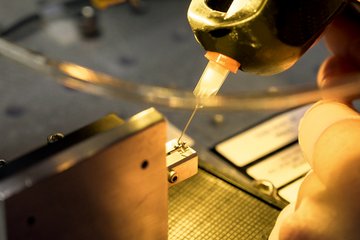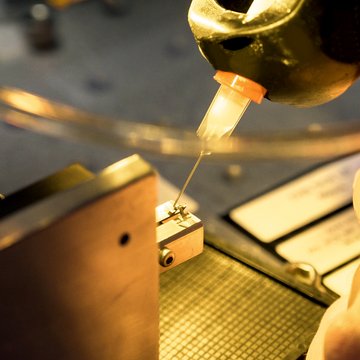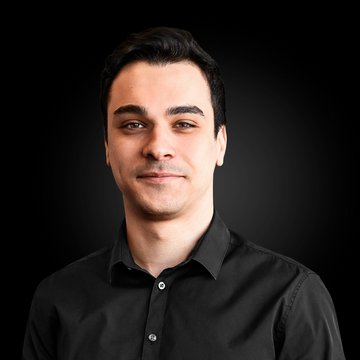The Road to Next-Generation LiDAR Sensors


Our Canadian facility in Vaudreuil-Dorion near Montreal has been designing and building pulsed laser diodes (PLDs) since 2002. From humble beginnings in a dark, empty warehouse, LASER COMPONENTS Canada has turned into a leading supplier of PLDs with wavelengths of 850 nm, 905 nm, and 1550 nm. In a market that is mainly driven by demanding industries such as the automotive and defense industries, the company has always managed to be on the edge of technological development. General Manager Jeff Briton will tell us about where PLD technology is heading.
PLDs are particularly used in time-of-flight-based distance measurement in which LiDAR is currently the most advanced field of application. At the moment, the automotive industry is the main driving force behind the development of this technology. It is already used in driver assistance systems such as autonomous emergency braking (AEB), but the technology still has a long way to go.
The industry is well known for its challenging demands such as operability within a wide temperature range and resilience against all kinds of shocks and vibrations. In addition to these requirements, automotive LiDAR must feature an exceptionally high resolution in future applications to detect and discern objects at greater distances and deliver a detailed 3D picture of any object in its range.
Short Pulse – High Resolution
Beyond Borders


One of the evolving technologies in this context is flash LiDAR. It promises a wider field of view without the use of any mechanical components to guide the beam, which makes it more robust and inexpensive. The challenge here is that it makes use of divergent laser emissions, which are considerably weaker than focused laser beams. Therefore, flash LiDAR not only depends on highly-sensitive single-photon detectors but also on powerful emitters that provide as much light as possible. LASER COMPONENTS is one of the few companies in the market that provide both emitters and detectors; however, since the detectors are provided by the LASER COMPONENTS Detector Group in Arizona, we will focus on the emitters.
To match the requirements of LiDAR and especially flash LiDAR, our engineers and technicians follow two possible strategies. The most common strategy to achieve a higher resolution is to keep the pulse lengths of the emitting diode as short as possible. Higher pulse frequencies result in a higher density point cloud and deliver a more detailed image of the vehicle’s surroundings in a shorter time. Thanks to elaborate drive electronics and a proprietary hybrid design, products such as our QuickSwitch® PLD provide pulses between 2 ns and 3 ns at pulse frequencies of over 200 kHz. We are currently developing new QuickSwitch® variations to extend our portfolio in this area. There are many ways to condition the output of our PLDs – drive electronics, collimating optics, and the PLDs themselves. We are concentrating on collimating optics for integration into our products for now, and further enhancements to the other designs are under investigation.
We are also extending our range of housing options. In addition to the common TO design, we offer several other housings and open carrier PLDs. These can also be delivered with fast-axis collimator optics to reduce beam divergence and facilitate easier optical design in the application. Customers can pick the right configuration to meet their requirements. In the case of distinctive demands, customers can count on our capable staff to come up with the right solution.
All the Emitters in a Row
Beyond Borders


The second strategy is to arrange the emitters in arrays. The most common configurations are linear arrays with 4, 8, or 12 elements in a row. We are currently considering various packaging options including ceramic, metal, encapsulated, and open carrier PCB. To create these arrays, we use the trench isolation method in which the emitting elements are separated by “trenches.” To achieve very high power, multiple emitters are combined electrically – either in series (power output is produced all at once with two electrical connections) or in parallel providing individually addressable emitters that can also be energized all at once using an appropriate multi-channel driver. Both designs have their limits to the physical spacing of the emitters which need to be considered in the customers’ design.
We also support this overall strategy by an extensive range of measurement capabilities. Even at short pulses of a few nanoseconds, we can determine whether our PLD meets the customer’s power specifications. In addition to this, we also invested in lifetime-testing equipment to prove the automotive-grade quality of our components.
All in all, I would say that we are very well equipped to meet emerging market requirements.

Click here
Download
Beyond Borders
LASER COMPONENTS France - Your competent partner for optical and optoelectronic components in France.
Welcome to LASER COMPONENTS S.A.S., your expert for photonics components. Each product in our wide range of detectors, laser diodes, laser modules, optics, fiber optics, and more is worth every Euro (€/EUR). Our customized solutions cover all conceivable areas of application: from sensor technology to medical technology. You can reach us here:
45 Bis Route des Gardes
92190 Meudon
France
Phone: +33 (0) 139 595 225
Email: serviceclient(at)



